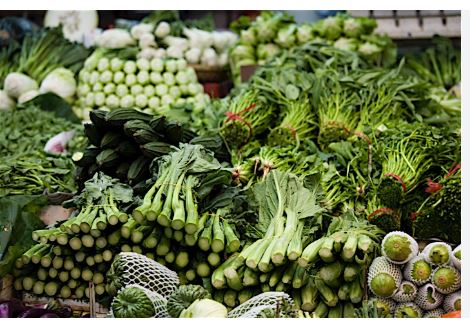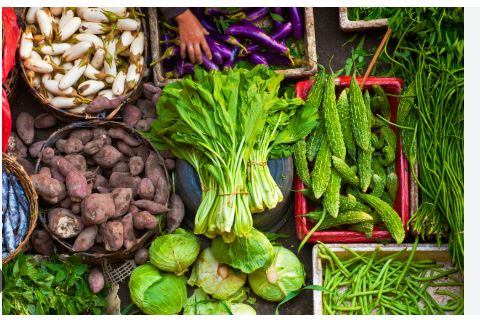
Chinese cuisine features a diverse array of vegetables that are integral to its culinary traditions, reflecting the country’s vast geographic and climatic diversity. These vegetables are cultivated across varied landscapes, from the temperate north to the subtropical south, and are adapted to local soils and seasonal cycles. They range from leafy greens and starchy roots to crisp pods and juicy gourds, each contributing unique textures and flavors to dishes. Many are prized for their nutritional benefits, including high levels of vitamins, minerals, and fiber, which align with traditional Chinese principles of balance and health in diet.
Historically, these vegetables have been central to Chinese agriculture and food culture for thousands of years, with cultivation techniques refined through ancient practices and documented in early texts. They were spread along trade routes, influencing and absorbing culinary traditions across Asia and beyond. Some were introduced from other regions and integrated into local diets, becoming staples over time. Their versatility allows them to be prepared in numerous ways—stir-fried, steamed, boiled, pickled, or raw—often paired with aromatic seasonings to enhance their natural qualities.
In Chinese cuisine, these vegetables are used in a wide range of dishes, from everyday stir-fries and soups to festive hotpots and banquet specialties. Regional cuisines highlight different preferences: northern dishes often feature hearty, cold-tolerant varieties, while southern cuisines emphasize delicate, quick-cooking types suited to warmer climates. Spicy and bold flavors dominate in some western regions, where vegetables are paired with intense seasonings. Preparation methods aim to preserve texture and freshness, reflecting a cultural emphasis on harmony in taste and presentation.

Chinese Vegetables
Napa Cabbage (Brassica rapa subsp. pekinensis)
- Description: Also called Chinese cabbage or snow cabbage, it has long, pale green leaves with white ribs, forming a tight, elongated head. Its texture is crisp yet tender.
- Uses: Widely used in soups, hotpots, stir-fries, and kimchi. It has a mild, sweet flavor and absorbs sauces well. Popular dishes include napa cabbage soup and stir-fried napa with garlic.
- Notes: Originating in northern China over 6,000 years ago, it’s a high-yield, durable vegetable stored for up to 5 months. It’s a symbol of prosperity in Chinese New Year dishes.
Bok Choy (Brassica rapa subsp. chinensis)
- Description: Known as pak choi or qingjiang cai, it has dark green leaves and thick, white or light green stalks, with a celery-like shape. Baby bok choy is smaller and tenderer.
- Uses: Stir-fried, steamed, or added to soups and noodle dishes. Its light, sweet flavor pairs well with oyster sauce or garlic. Popular in Cantonese cuisine.
- Notes: Packed with vitamins A and C, it’s one of the most common Chinese greens in Western markets. Shanghai bok choy and dwarf varieties are milder and sweeter.
Chinese Broccoli (Brassica oleracea var. alboglabra)
- Description: Called gai lan or Chinese kale, it has thick, glossy blue-green leaves, sturdy stems, and small white flowers. It resembles broccoli but is leafier.
- Uses: Stir-fried with garlic, ginger, or oyster sauce, often served at dim sum restaurants. Its bittersweet, earthy flavor complements strong seasonings.
- Notes: Best in cooler seasons, it’s a staple in southern China, particularly Cantonese cuisine. It’s rich in vitamins A, C, and K.
Chinese Long Beans (Vigna unguiculata subsp. sesquipedalis)
- Description: Also known as yard-long beans or snake beans, these are thin, dark green beans growing up to 3 feet long, related to cowpeas.
- Uses: Stir-fried with garlic, black beans, or Sichuan peppercorns, often in Sichuan dishes. They have a crunchy texture and mild, green bean-like flavor.
- Notes: Popular in southern China and Cantonese cooking, they’re also used in Malaysian and Thai dishes. They’re pickled for condiments.
Bitter Melon (Momordica charantia)
- Description: A warty, oblong gourd with dark green, pockmarked skin. Its intensely bitter flesh becomes reddish and sweeter when ripe.
- Uses: Stir-fried with black bean sauce, pork, or beef, or used in soups and teas. Blanching reduces bitterness. Popular in stir-fries like beef with bitter melon.
- Notes: Grown in tropical regions, it’s valued for potential health benefits like blood sugar control. Its taste is an acquired one, often paired with bold flavors.
Lotus Root (Nelumbo nucifera)
- Description: The underwater rhizome of the lotus plant, it’s cylindrical with pipe-like holes, white when peeled, and crisp with silk-like fibers.
- Uses: Sliced for stir-fries, soups, or cold dishes, often stuffed with meat or glutinous rice. It’s sweet and crispy when raw, softening when cooked.
- Notes: Hubei is famous for lotus root production. It’s a symbol of purity and commonly used in autumn dishes across China.
Potatoes (Solanum tuberosum)
- Description: A starchy tuber, typically round or oval, with thin brown skin and white or yellow flesh. China is the world’s largest potato producer.
- Uses: Stir-fried as thin slices with vinegar or spices (e.g., Sichuan hot and sour potato stir-fry), or used in soups and stews. Not a staple but a popular side.
- Notes: Especially common in northeastern China, Xinjiang, and Sichuan, where spicy potato dishes are favored. Introduced in the 16th century.
Tomatoes (Solanum lycopersicum)
- Description: Round, red fruits (culinarily vegetables) with juicy flesh. Called fanqie in the south and xihongshi in the north.
- Uses: Stir-fried with eggs (a classic home dish), used in soups like tomato egg-drop soup, or processed into ketchup. Adds a sour-sweet balance.
- Notes: Not native to China, tomatoes are now widely grown (31% of global production) and used in both Chinese and Western-style dishes.
Chinese Eggplant (Solanum melongena)
- Description: Long, slender, and purple or lavender-streaked, with thin skin and tender flesh. Varieties like ‘Ping Tung Long’ are glossy and heat-tolerant.
- Uses: Stir-fried (e.g., Sichuan fish-fragrant eggplant), braised, or stuffed with meat. Its soft texture absorbs flavors like garlic and soy sauce.
- Notes: Common in southern China, it’s picked young to avoid toughness. It’s a warm-season crop rich in antioxidants.
Daikon Radish (Raphanus sativus var. longipinnatus)
- Description: A long, white, cylindrical root (8–12 inches), also called Chinese or white radish, with a crisp texture and mild, sweet flavor.
- Uses: Used in soups, stews, stir-fries, or pickled as a side dish. Popular in braised daikon with soy sauce and ginger.
- Notes: Less peppery than red radishes, it’s low in calories and rich in vitamin C. Widely used in East Asian cuisines, including Japanese daikon dishes.
Snow Peas (Pisum sativum var. saccharatum)
- Description: Flat, bright green pods with small, tender peas inside, known for their crisp texture and sweet, delicate flavor.
- Uses: Stir-fried with meats or other vegetables, added to soups, or used raw in salads for crunch. Common in spring dishes.
- Notes: Called “Holland beans” (he lan dou) in Chinese, they’re a cool-season crop high in vitamins C and A. Popular across China.
Choy Sum (Brassica rapa var. parachinensis)
- Description: Also called yu choy, it has crisp green stems, tender leaves, and small yellow flowers. It’s sweeter than gai lan with a bok choy-like texture.
- Uses: Lightly stir-fried with garlic or soy sauce, steamed, or added to noodle soups. Requires minimal cooking to retain crunch.
- Notes: A Cantonese favorite, it’s rich in vitamins A, C, and K. It’s in season during spring and fall.
Chinese Mustard Greens (Brassica juncea)
- Description: Known as gai choy, it has a large bulbous stem and leafy greens, with a bitter, peppery flavor. Several subspecies exist.
- Uses: Stir-fried, pickled, or added to soups. Popular in Sichuan and Cantonese dishes, often paired with pork or fermented beans.
- Notes: An acquired taste, it’s nutritious with anti-inflammatory properties. Common in southern and western China.
Bamboo Shoots (Bambusa spp. or Phyllostachys spp.)
- Description: Tender, edible shoots of bamboo plants, pale yellow when fresh, with a mild, earthy flavor and crisp texture.
- Uses: Stir-fried, added to soups, or used in spring dishes like bamboo shoot stir-fry with pork. Fresh shoots require boiling to remove bitterness.
- Notes: Available fresh or canned, they’re a spring delicacy in southern China, rich in fiber and low in calories.
Mung Bean Sprouts (Vigna radiata)
- Description: Slender, white sprouts with small green beans, offering a juicy, crunchy texture and mild flavor.
- Uses: Stir-fried (e.g., with garlic chives), added to fried rice, noodle dishes, or used raw in salads. A common side dish.
- Notes: Easy to grow, they’re rich in antioxidants and vitamin C. Widely consumed in East and Southeast Asia.
Watercress (Nasturtium officinale)
- Description: A leafy green with small, round leaves and hollow stems, known as xi yang cai (“Western vegetable”). It has a peppery, tangy flavor.
- Uses: Stir-fried with garlic, used in soups, or eaten raw in salads. Popular in Guangdong cuisine.
- Notes: Introduced from Portugal in the 1930s, it’s high in vitamins C and K and grows in wet conditions.
Chinese Celery (Apium graveolens var. secalinum)
- Description: Thinner, hollower, and more aromatic than Western celery, with curved stalks and a strong, herbaceous flavor.
- Uses: Stir-fried (e.g., with beef or tofu), used in soups, or as a garnish. Leaves are also edible, adding flavor to dumplings.
- Notes: Common in Shanghai and northern China, it’s valued for digestion and has a herb-like intensity.
Shepherd’s Purse (Capsella bursa-pastoris)
- Description: A wild leafy green (ji cai) with small, lobed leaves and a unique, slightly peppery flavor. Often sold frozen outside China.
- Uses: Used as a filling for dumplings, wontons, or steamed buns with pork, or added to soups and porridges.
- Notes: Traditionally foraged in Shanghai, cultivated varieties are less aromatic. It’s sandy and requires thorough washing.
Pea Shoots (Pisum sativum)
- Description: Tender leaves and stems of pea plants (dou miao), light green and delicate, with a sweet, pea-like flavor.
- Uses: Stir-fried with garlic or added to soups and salads. A popular fall and winter green in northern China.
- Notes: High in fiber and antioxidants, they’re pricier in Western markets but a seasonal delicacy in China.
Celtuce (Lactuca sativa var. angustana)
- Description: Also called you mai cai or AA choy, it has tender, bibb lettuce-like leaves and a crisp, cucumber-like stem with a mild flavor.
- Uses: Leaves are used in salads or stir-fries; stems are stir-fried with eggs or sliced raw. Popular in Taiwan and mainland China.
- Notes: Both parts are edible, offering vitamins A and C. It’s a specialty green less known outside Asia.
Winter Melon (Benincasa hispida)
- Description: A large, round gourd with waxy, green skin and white, mild flesh, also called daikon or wax gourd.
- Uses: Used in soups (e.g., winter melon soup with pork broth), stir-fries, or candied as a snack. It absorbs flavors well.
- Notes: Common in southern China, it’s low in calories and used in summer dishes for hydration.
Additional Notes
- Culinary Versatility: These vegetables are integral to Chinese cuisine, often stir-fried, steamed, or boiled to retain texture and nutrients. Many are paired with garlic, ginger, soy sauce, or oyster sauce to enhance flavors.
- Nutritional Value: Most are rich in fiber, vitamins (A, C, K), and minerals (calcium, iron), supporting digestion, immunity, and overall health. Leafy greens like bok choy and napa cabbage are particularly nutrient-dense.
- Regional Preferences: Northern China favors hardy greens like napa cabbage and potatoes, while southern regions use delicate greens like choy sum and long beans. Sichuan and Hunan cuisines emphasize bold flavors with vegetables like mustard greens and bitter melon.
- Availability: Many of these vegetables (e.g., bok choy, napa cabbage, gai lan) are now widely available in Western supermarkets or Asian markets. Others, like shepherd’s purse or celtuce, may be found frozen or at specialty stores